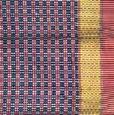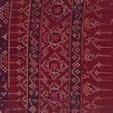Basic HTML Version




สาขางานช่
างฝี
มื
อดั้
งเดิ
ม
มรดกภู
มิ
ปั
ญญาทางวั
ฒนธรรม
48
Yok cloth
uses the heald-lifting technique whereby
the heald shafts are lifted to allow the insertion of
extra wefts, which lay on the top layer, to create
various motifs. If the extra wefts are of silk yarns,
the cloth is called Yok Mai cloth (Mai - silk), if they
are of golden si lk yarns, the cloth is cal led
Yok Thong cloth (Thong - gold, golden).
The key characteristic of this technique is the
addition of the extra wefts throughout the length
of the fabric and intermittently, as required by the
design, by lifting the heald shaft to insert the extra
wefts to create raised moti fs. Other weaving
techniques are also incorporated to create intricate
motifs such as the extra warp technique, the tie-dying
of weft and warp yarns before weaving, and the
intermittent weft technique, for example.
Yok cloth was first used by the people who
lived in the Chao Phraya River Basin and the upper
part of the Thailand’s southern peninsula. It enjoyed
widespread use among the people in the royal
court and the commoners who used it as skirt,
cloak, sash, napkin etc. It was highly considered
and was used on special occasions to show off one’s
status and enhance one’s personality. Several customs
exist that prescribe the use of Yok cloth.
During the reign of King Rama V, the use of Yok
cloth spread from the communities living in the
Chao Phraya River Basin and the upper part of the
southern peninsula to other societies and regions
such as the Lanna and the Isan (the northern and
the northeastern regions of Thailand) where the Yok
cloth weaving technique is incorporated and blended
with the local weaving tradition of these regions.
This gave birth to several types of Yok cloth
Yok Cloth
with local character and identity -- Yok Lanna
cloth and Yok Ubon (province) cloth, for example.
Today, Yok cloth is widespread and well-known
throughout all regions of Thailand.
The intricate designs of Yok cloth have aesthetic
value that inspire and stimulate artistic creativity.
Moreover, the subject-matters and the intangible
cultural contexts -- the function and use, the allocation
of space for putting in the motifs on the fabric,
the motif designs, the material used, the tools
and technology involved, the l ink between
the fabric and the environment, for example -- are
testimony to the collective cultural memory.
They record and tell history and reflect the social
development and the economic structure of the
country.

